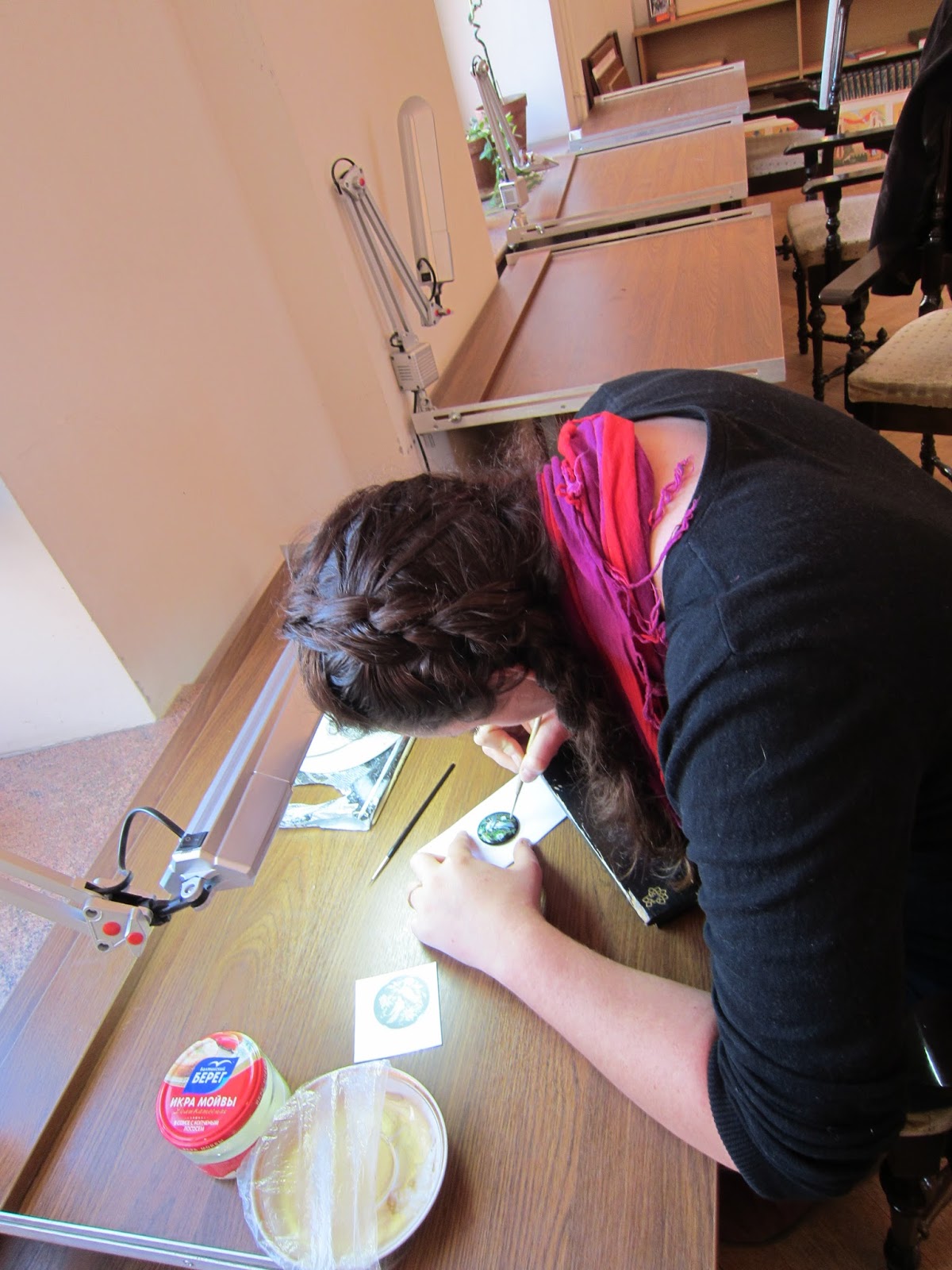Sunday, September 15, 2013
Peterhof
Gold
The last step in the Palekh painting process is to add gold. To create the gold paint you need to mix gum arabic with water and then mix gold leaf into this mixture. You need to mix it with your finger in a small plate for approximately 50 minutes. Between pumicing my brooch and mixing gold paint, I almost had blisters on my fingertips! Before you start painting gold, you need to put a thin layer of emulsion over the lacquered layer. This allows a more absorbent surface for painting. You can also put more layers of lacquer and then pumice the surface.
This step in the process was very scary. It was very hard to gauge how much gold you had on your brush, and this was the step that needed the finest detail. You can see how we are bent over our paintings. We needed to get very close to paint and see the detail. Our necks and backs were always stiff after class!
Melissa chose to put gold crowns on her birds. They turned out wonderfully!
After we painted the gold and allowed it to dry, we needed to polish the gold areas. This is traditionally done using the tooth of a wolf. You can also use the end of a thermometer. After we polished our brooch, we added another layer of lacquer.
We were very sad to say goodbye to the school and our instructor. She had such a kind heart and was very patient with teaching such beginners.
Dasvedanya!
Hermitage: The Secret Collection
I was so excited to learn that we would be able to visit the Hermitage because I would be able to see the "Secret Collection". I often teach my students about the Impressionist movement and I feel honored to actually view some of the work "in person". The secret collection consists of Impressionist and Post-Impressionist paintings that were originally from German private collections, but were taken to the Soviet Union after WWII. These paintings were often written about as being lost, however, in 1994 it was revealed that the Hermitage was going to be showing them in an exhibition. Here is a link to an interesting article in the New York Times: http://www.nytimes.com/1994/10/04/arts/hermitage-reveals-it-hid-trove-of-impressionist-art.html
Here are some images of the paintings that we were able to see:
Here are some images of the paintings that we were able to see:
The State Hermitage Museum
We were able to visit the State Hermitage Museum in St. Petersburg. The school we are attending set up a guided tour and we were very thankful for the direction. The museum is huge! The collection contains more than 3 million works of art! The main building of the Hermitage is in St. Petersburg and is called the Winter Palace. The Winter Palace was a former residence of the Russian emperors and is situated on the Neva Canal. It was quite impressive.
Our guide told us that when the palace was a residence, there were 600 servants and 200 of those servants took care of the chandeliers! I was continuously getting distracted by the beautiful floors. Here is a photo of my favorite.
We were able to explore room after room of famous artwork. We were lucky to go on a Wednesday because the museum stays open late!
We were able to see one of Michaelangelo's sculptures.........
And two of DaVinci's paintings..........
And a large number of Rembrandt's..................
Our guide told us that when the palace was a residence, there were 600 servants and 200 of those servants took care of the chandeliers! I was continuously getting distracted by the beautiful floors. Here is a photo of my favorite.
We were able to explore room after room of famous artwork. We were lucky to go on a Wednesday because the museum stays open late!
We were able to see one of Michaelangelo's sculptures.........
And two of DaVinci's paintings..........
And a large number of Rembrandt's..................
By the end of the day we were pretty pleased but VERY tired.
Subscribe to:
Posts (Atom)


















































